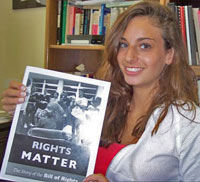CONSTITUTION DAY ACTIVITY 2
Who Will Sign This Petition?
On July 4, 1951, John Patrick Hunter, a young reporter in Madison, Wisconsin, put the preamble to the Declaration of Independence and part of the Bill of Rights on a petition and asked 112 members of the public to sign it. Only one person did.
The rest refused. Some thought that signing the petition would get them in trouble. Some thought it seemed "subversive" and aimed at the overthrow of the government.
Some fifty-five years later, a Knight Foundation survey of more than 100,000 high school students found that 3 in 4 didn't know how they felt about the First Amendment or were largely indifferent to it. Only half thought newspapers should be allowed to publish freely without government approval.
How would students in your school react if asked to sign Hunter's petition today? Would they recognize where it comes from? Why don't you find out?
First, ask your students if they know where the language of the petition comes from. Then have them read the preamble to the Declaration of Independence and the First Amendment.
Give them copies of the petition and ask them try to get signatures. And then ask them what happened when they tried to get other students to sign. Did they recognize the language? Who was willing to sign? Who was not willing to sign? Why not?
Below is an account by one high school senior of what happened when she tried to get students in her school to sign the petition. Have it read aloud in the class and see what your students think of it.
If you carry out this activity, we would be interested in the results. Please email a summary to nancy@aclum.org.
What Happened When I Asked My Classmates to Sign a Petition
by Allison Frankel
 I am a high school senior. After reading the activity about getting signatures on a petition that combines parts of the Declaration of Independence and First Amendment, I decided to try it out for myself. I got some interesting results.
I am a high school senior. After reading the activity about getting signatures on a petition that combines parts of the Declaration of Independence and First Amendment, I decided to try it out for myself. I got some interesting results.
Most people in my school I talked to about signing the petition recognized that the language came from an historical document, but didn't know which one. Many thought it was the Constitution. A class of juniors asked me if I was planning a revolution.
It was really hard to get the first signature. Most people were nervous about putting down their address and phone number. They didn't want an organization to pester them with phone calls.
A teacher of mine was the first to sign. After he signed, most of his class followed suit. Everyone pretty much followed the crowd. Two people in the first class refused to sign. One claimed it was a trick. The other said there was no point in signing because we already have a Declaration of Independence.
I discovered that underclassmen were more willing to sign than seniors. People who were politically active and recognized the language were more likely to refuse! Multiple members of the Mock Trial team asked if I had altered the documents. One person even looped up the Declaration of Independence on the Internet to cross-reference it. He ended up putting down his name, but not his phone number or address.
I really learned a lot about the makeup of my student body, and the fear of dissent. Why don't you try it too? It definitely brightens up the school day. Then let me know your results on my Facebook blog – Ask Allison, where you can talk about student rights, the Constitution, and any other current events on your mind. If you don't have a Facebook account, get one today – it's free. See you soon!
http://www.facebook.com/group.php?gid=2837540306